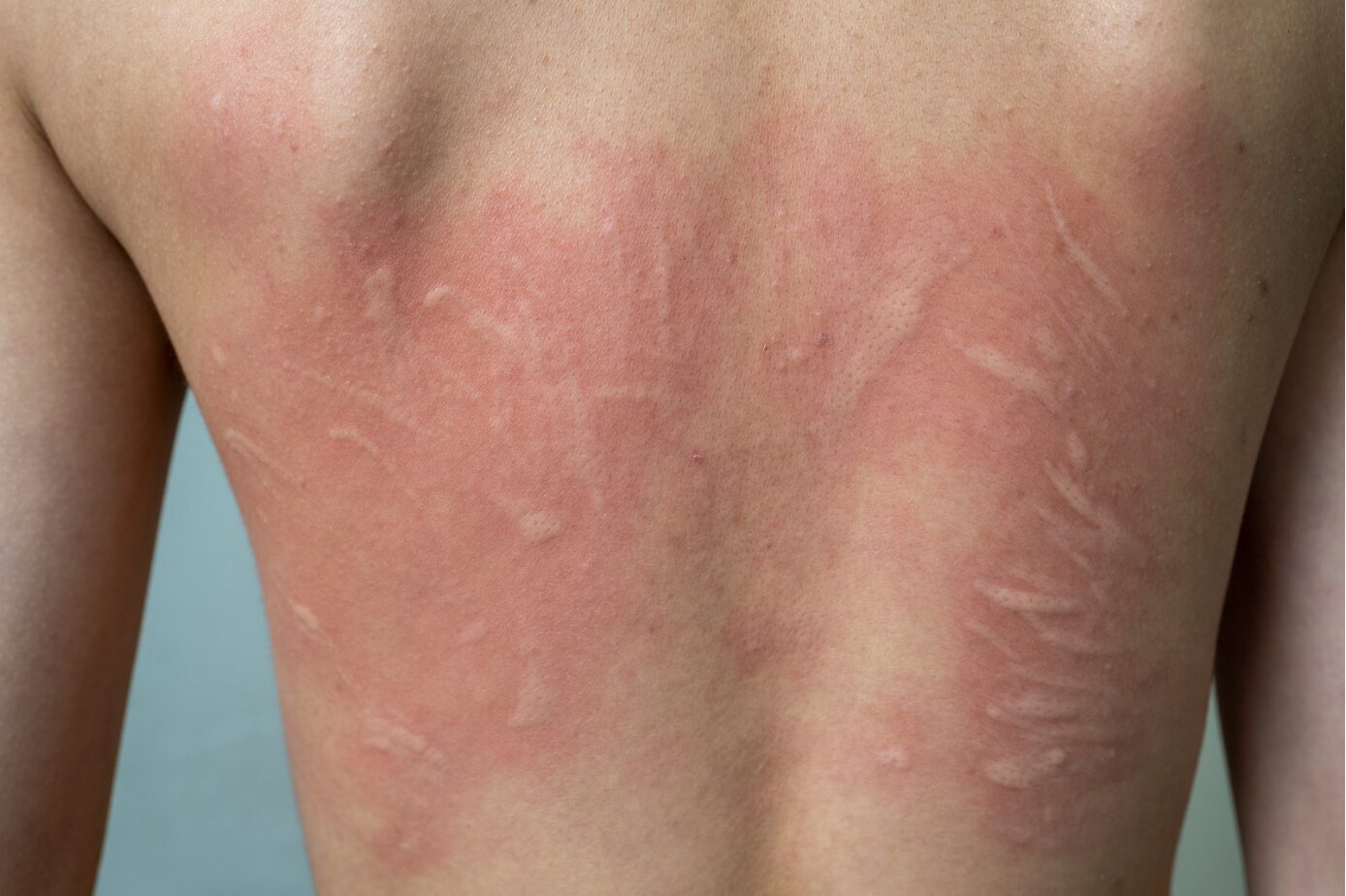Urticaria: Symptoms, Causes, Treatment
What are the symptoms of urticaria?
Urticaria, commonly known as hives, is a skin condition characterized by raised, red, itchy welts or plaques (wheals) that can vary in size and shape. The symptoms of urticaria can include:
- Raised, red welts: These welts can vary in size from small spots to large plaques and may be round, oval, or irregular in shape.
- Itching: The welts are often accompanied by intense itching, which can be very bothersome.
- Swelling: The affected area of skin may become swollen or raised.
- Burning or stinging: Some people may experience a burning or stinging sensation in addition to itching.
- Pale centers: The center of each welt may be pale in color, giving the welts a “white” appearance.
- Symmetrical appearance: The welts often appear in clusters or groups and may be symmetrical, meaning they occur on both sides of the body.
- Short duration: Individual welts typically last for a few hours to 24 hours before fading away, but new welts may appear as old ones fade.
- Recurrent episodes: Urticaria can be acute, lasting for a few days to weeks, or chronic, lasting for months or even years with recurrent episodes.
In addition to these symptoms, some people with urticaria may also experience swelling of the lips, eyelids, hands, or feet (angioedema) or other symptoms such as fever, joint pain, or difficulty breathing. Urticaria can be caused by a variety of factors, including allergic reactions, infections, medications, and physical stimuli (such as pressure, cold, or sun exposure). If you are experiencing symptoms of urticaria, it’s important to see a healthcare provider for an accurate diagnosis and appropriate treatment.
What are the causes of urticaria?
Urticaria, commonly known as hives, can be caused by a variety of factors, including:
- Allergic reactions: Urticaria is often caused by an allergic reaction to certain foods, medications, insect bites or stings, latex, or other allergens. In allergic urticaria, the body releases histamine and other chemicals in response to the allergen, leading to the characteristic skin rash and itching.
- Infections: Some infections, such as viral infections (e.g., the common cold, hepatitis, Epstein-Barr virus) and bacterial infections (e.g., urinary tract infections, strep throat), can trigger urticaria.
- Medications: Certain medications, such as antibiotics (e.g., penicillin, sulfa drugs), nonsteroidal anti-inflammatory drugs (NSAIDs) like aspirin and ibuprofen, and blood pressure medications (e.g., ACE inhibitors), can cause urticaria as a side effect.
- Physical stimuli: Physical stimuli such as pressure (dermatographism), cold (cold urticaria), heat (cholinergic urticaria), sunlight (solar urticaria), or water (aquagenic urticaria) can trigger urticaria in some people.
- Emotional stress: Emotional stress can sometimes trigger or exacerbate urticaria.
- Underlying medical conditions: Urticaria can be associated with certain underlying medical conditions, such as autoimmune disorders, thyroid disease, and certain cancers.
- Idiopathic urticaria: In many cases, the exact cause of urticaria is not identified, and it is referred to as idiopathic urticaria.
It’s important to note that the underlying cause of urticaria can vary widely among individuals, and in some cases, the cause may never be identified. If you are experiencing urticaria, it’s important to see a healthcare provider for an accurate diagnosis and appropriate treatment.
What is the treatment for urticaria?
The treatment for urticaria, commonly known as hives, depends on the underlying cause and the severity of the symptoms. In many cases, acute urticaria resolves on its own within a few hours to days and may not require treatment. However, if urticaria is persistent, recurrent, or causing significant symptoms, treatment options may include:
- Antihistamines: Antihistamines are the primary treatment for urticaria and work by blocking the effects of histamine, a substance released by the immune system during an allergic reaction. Antihistamines can help relieve itching, redness, and swelling associated with urticaria. They are available over-the-counter or by prescription.
- Corticosteroids: In some cases, corticosteroids may be prescribed to reduce inflammation and relieve severe itching and swelling. Oral corticosteroids are typically used for short periods to avoid long-term side effects.
- Topical treatments: For localized urticaria or itching, topical treatments such as calamine lotion, corticosteroid creams, or menthol-based creams may be applied to the affected area to help relieve symptoms.
- Avoidance of triggers: If the underlying cause of urticaria is known (such as certain foods, medications, or environmental factors), avoiding triggers may help prevent or reduce episodes of urticaria.
- Other medications: In some cases, other medications such as leukotriene receptor antagonists, omalizumab (an anti-IgE antibody), or cyclosporine may be prescribed for chronic or severe urticaria that does not respond to antihistamines or corticosteroids.
- Identifying and treating underlying conditions: If urticaria is caused by an underlying medical condition, such as an infection or autoimmune disorder, treating the underlying condition may help alleviate urticaria symptoms.
It’s important to work closely with a healthcare provider to determine the underlying cause of urticaria and develop an appropriate treatment plan. In some cases, urticaria may be a sign of a more serious allergic reaction or underlying medical condition that requires prompt medical attention.




